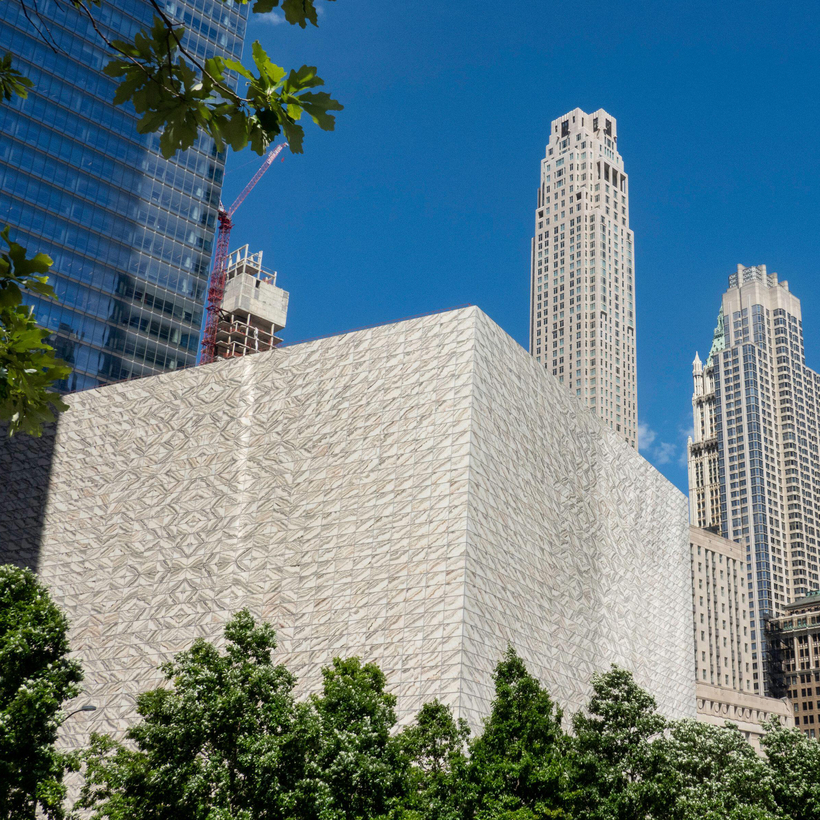A self-transforming building may sound like a 21st-century fantasy, but ancient Rome, just before the reign of Julius Caesar, took a crack at constructing one. A pair of back-to-back theaters presented plays in the morning and then rotated to form a single amphitheater for gladiator battles in the afternoon. The first-century historian Pliny the Elder tells us that “the Roman people themselves, as they spun round in their seats, were in far greater peril than the gladiators.” It’s taken a couple thousand years to work out the kinks, but in three days a trio of intimate, radically transformable theaters debuts in New York, at the Perelman Performing Arts Center (PAC NYC).
Located just north of the 9/11 Memorial & Museum, PAC NYC is a monumental cube of translucent Portuguese marble. Concealed within it are three performance spaces, which can be configured separately or together in at least 60 different arrangements, a flexibility that opens up all kinds of possibilities for plays, dance, music, opera, film, and more. The design of the center has been a long time coming. The first tentative steps were taken in 2004 with the appointment of Frank Gehry as architect, but the site—at the time it was called the Performing Arts Center at the World Trade Center (W.T.C.)—was bedeviled by logistical and political complexities that led to 10 years of delays.

The story of the current design begins around 2013. Maggie Boepple, who put in a seven-year tenure as the president and director of the project at the W.T.C., loved the lively vibe she’d experienced in the three-theater complex that houses the scrappy Young Vic, in London. Its spaces could be ripped apart and reconfigured with novel layouts for new productions. She brought on the Young Vic’s artistic director, David Lan, and its theater consultant Gavin Green, of the firm Charcoalblue, to help plan a design competition for the Performing Arts Center at the W.T.C.
The constant rebuilding of theater interiors is expensive. Luckily, a pair of architects had recently cracked that nut at the Wyly Theatre, in Dallas. Joshua Ramus, the founding principal of the New York architecture firm REX, and the Dutch architect Rem Koolhaas used tried-and-true theater equipment such as winches and lifts to produce a performance space that could be affordably transformed in a single day. It proved so effective that the Wyly’s first 25 productions used 23 unique layouts.

In 2015, with a vision largely unchanged to this day, Ramus won the competition to design the W.T.C. performing-arts center. You could say the building is the love child of London’s Young Vic and Dallas’s Wyly, for here again are three intimate theaters that mechanically transform. Charcoalblue joined the team that brought the project to completion, and six months after the competition, Ronald O. Perelman made a $75 million donation that kicked everything into high gear and gave the complex its new name.
As with all his work, Ramus challenges norms at PAC NYC. Traditionally, theaters have boosted the excitement of arriving audiences by promenading them through elaborate sequences of lobbies. The PAC NYC’s approach is different. Its lobby, fitted out by the Rockwell Group, is a place to hang out and cool out, a sort of public living room. For theater patrons, there’ll be no knowing exactly what beckons in the 3D puzzle of performance spaces that lies an elevator ride above. The bet is that audience expectations will fuel audience excitement. Ramus won a similar wager at the Wyly.

PAC NYC is a mystery box concealing ever changing surprises. But this mute white cube is also a masterful minimalist sculpture placed on its site with all the care of a Donald Judd installation. Its square footprint is rotated just enough from the surrounding grid of skyscrapers to make it stand out and apart. And the building’s color is central to its respectful relationship with its tragic Ground Zero site. Standing over the dark voids of the 9/11 memorial pools, its equally simple white form evokes hope and optimism. All the more so when dusk falls and the structure glows with a warm inner light.
The Perelman Performing Arts Center, in New York City, is now open
Check out AIR MAIL’s Arts Intel Report, our newly revamped research tool for what to do and where and when to do it
Lewis Jacobsen keeps an eye on art and design from his aerie in upper Manhattan while overseeing his New York architectural practice

